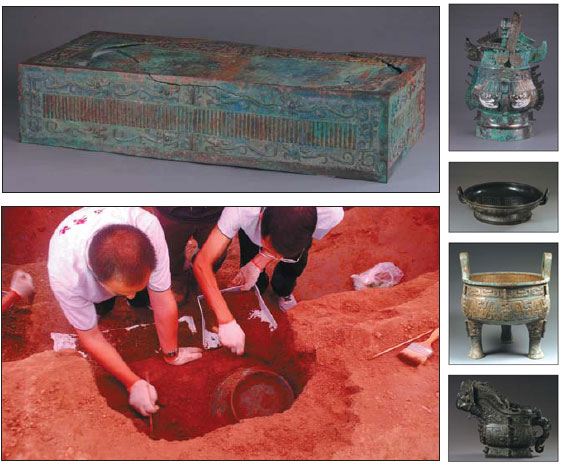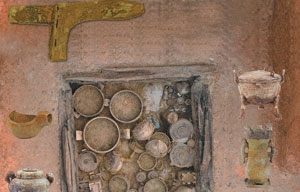Cast in bronze
Updated: 2013-03-14 10:02
By Wang Kaihao (China Daily)
|
|||||||||||
 |
|
Clockwise from top left: Jin and four other bronze ware items from Baoji are some of the exhibition's highlights. Archaeologists unearth bronze ware from a relic site in Baoji. Photo provided to China Daily |
The jin on the exhibition is 94.5 cm long, 45 cm wide, and 20.5 cm tall, weighing about 42 kg. Academics have not reached a consensus to explain why the jin is so rare. One likely reason: this huge piece has to be cast as a whole, with a highly demanding technique.
"Maybe the other explanation is that only the people here are so obedient in making the items while other places didn't follow the king's guidance," Yang jokes.
More than 10 villagers at Shigu found bronze ware in 2012. Each of them, including Xu, got 5,000 to 15,000 yuan ($804-2,400) as a reward. This led to the discovery of the tomb of an early Western Zhou Dynasty aristocrat, which has been the last decade's most important archaeological discovery in Baoji.
In the past decade, Yang says, the government has spent at least half a million yuan to reward locals who contribute to the protection of historical relics, after 25 important findings were reported.
Since 2003, the city has been pointed out as one of the finest examples on the protection of historical relics. While the government actively promotes relevant national laws in rural communities, Yang confesses there still are some cases of tomb raiding every year. Baoji police authority arrested 101 grave-robbery suspects in 2012 and recovered 438 pieces of stolen antiques.
"It is a must to simultaneously stop the crimes and better educate the people," Yang says proudly. "Fortunately, people in Baoji are nice.
"As we live on this land, we cannot let its tangible history die away."
Contact the writer at wangkaihao@chinadaily.com.cn.
|
|
|
| Nature's nirvana | History unfolds |
Related Stories
Heritage being nursed back to health 2013-02-22 14:48
Mogao Grottoes murals prepped for digital display 2013-02-06 11:07
Hidden gems of history 2013-02-05 15:36
Top 10 cultural news of 2012 in China 2012-12-28 15:47
Gleaming with tradition 2012-12-27 13:56
The well explored charm of Lijiang 2012-12-18 14:14
Today's Top News
Police continue manhunt for 2nd bombing suspect
H7N9 flu transmission studied
8% growth predicted for Q2
Nuke reactor gets foreign contract
First couple on Time's list of most influential
'Green' awareness levels drop in Beijing
Palace Museum spruces up
Trading channels 'need to broaden'
Hot Topics
Lunar probe , China growth forecasts, Emission rules get tougher, China seen through 'colored lens', International board,
Editor's Picks

|

|

|

|

|

|







